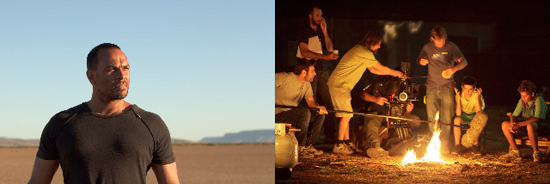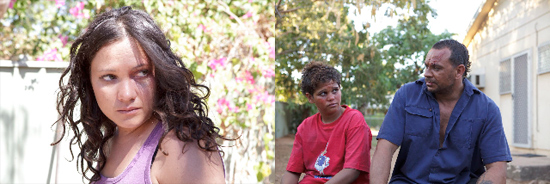Why do anything conventionally these days? How do we make our work fresh? Sometimes it makes sense to rethink it all. Can it ever be done by working within the state-ordained system. Today MAD BASTARD’s Brendan Fletcher continues his exploration of these and other questions.
2. MAD PRODUCTION
Trying to think independently whilst operating within the system had it’s most razor-sharp edge during the shoot itself.
I knew from the test shoots that when our real people starting “acting” they were unconvincing, but when they were just “being themselves” they were great. They resisted learning lines and preferred to just discuss the scene then shoot it, using words that came to them in the moment. And I liked this, because I wanted the script to bend and stretch each day, so that the actors could bring real spontaneity to their performances. I also planned to shoot real events as they happened in the community – hunting scenes, floods, funerals etc – to bring a gripping reality to the film. That was the idea anyway.

(Dean (TJ) on set; Me looking stressed as we shoot a scene with child performers Lucas Yeeda and Patrick McCoy-Geary)
This would have been fine in the 4 months, micro-crew shoot model, but with a full 35mm crew, a six week shoot and two thousand kilometres of travel to do – this thinking was a serious logistical challenge to our production.
The “big production” we became saw our hand-nurtured non-actors plunged into entirely unfamiliar terrain. The process of call sheets, ADs, catering trucks, make up vans, taking off their own clothes and putting on the clothes of other people was a massive diversion from the authenticity of how we’d done all the tests. Our relationship “like family” was nearly entirely lost amongst a sea of new people that had never been to an Aboriginal community before.
Our process was now almost entirely conventional, but I was convinced we needed to work like we had in the test phase. I still wanted flexibility, but the PRODUCTION ENTITY demanded certainty, long term pin-point accuracy. The departments (I had departments now!) needed information to plan effectively, but I wanted to promise very little so as to keep spontaneous.
We ended up terribly stuck in the middle. A process that was neither fish-nor-foul. The logistical detail the production needed kept changing as scenes would bend even as they were being shot. And the powerful, almost magical, natural performances we captured in years of tests felt impossible to re-create now that we were shooting the ACTUAL film. Our process was as nurturing as a sledge-hammer. I described it as “sending a gorilla out to pick flowers.”
The shit hit the fan. Scenes were invented, scenes were dropped, new characters were introduced and others written out – and I was rewriting into the wee hours of every night. We were getting good stuff amongst it all, but it was hard to “see the wood from the trees” in the eye of the storm.
It sounds mad and it sure felt like it. The investors were unsure whether it was really exciting or a big mess. Some of the crew too. Advisors were dispatched, rushes were scrutinized and my whole approach was called into question by the system itself.
As if all this wasn’t enough, in the middle of the shoot our Theatrical Distributor went out of business in a post-GFC funk. It couldn’t get much worse.
But as they say, the darkest hour is just before the dawn.
3. REDEMPTION
The film is a story about redemption – possible for even the “maddest” of us. It’s funny how the process of making the movie charted that journey in a way too.
Submerged under an ocean of stress and forced to act differently or sink, two things happened:
Firstly, I realized I had to face reality: my indie-dream was over. The only way I would get through was to quit pining for the flexible old model and to embrace the “system” of the larger crew. So, literally overnight, I did.
We quit the improvising and I gave the crew a few unscheduled days off and locked myself away to write the remaining scenes definitively. It was every writers worst nightmare. Days, sometimes hours to write a scene before it needed to be shot. But in the heat of that moment, some good material tumbled out onto the page.
The second major thing I realized was about the cast: my NON-ACTORS after a few weeks of shooting had now become ACTORS. No longer phased by the cameras, lights and big crew … they began to deliver solid performances without me having to clear the set. They began to ASK for rehearsals. They started to WANT to learn the lines because they understood they needed to do that in order to nuance their performances.

(Our “non-actors” became fantastic actors as the shoot went on)
In just a couple of days, everything turned around. And it worked.
The two processes began to merge. As the cast and crew got more confident, we’d do a take as scripted and then we’d do an improvised take. And where time and stock allowed, we’d allow scenes to grow and evolve off the bedrock of the page. Things clicked and everyone could feel it.
Sometimes it felt like the wild indie would be leading the “system”, and at other times the “system” would provide the security that the wild indie needed. It was truly organic, both processes winding around each other, with me as a director in between. In the final film it is impossible to put a finger on which scenes were shot which way (sometimes even for me!) and the result is fluid and connected.
With the rushes displaying more clarity, key investors were won over, and they found the confidence to be patient. They had the grace to allow us a solid 12 weeks cutting until seeing a rough cut, and that gave us the time we needed. From that point on the only way was up.
But even in the edit, the indie-spirit battled convention. I use alot of on-screen music performed by local music legends the Pigram Brothers (think O Brother Where Art Thou). Balancing the needs of narrative drive with my desire to create a unique feeling with the use of on-screen music was a very difficult balance to juggle. It took a long time in the cut to get right, and I know it hasn’t worked for some industry folk – but that’s a price you pay for sticking to a creative direction.
After a healthy pick up shoot, the movie really came together – but we had no distributor! So we had an industry screenings and the next day got the call from Transmission/Paramount.
I will never forget the shaking all over my whole body when Sundance invited us to screen in the 2011 World Cinema Competition. From disaster to Sundance! There, we were picked up by IFC’s Sundance Selects program for North American distribution. Our soundtrack also got picked up and we ran a significant music campaign to support the promotion of the movie.
Maybe not so mad after all.
— Brendan Fletcher
Brendan is currently working with Writer/Producer Train Houston on the Jeff Buckley pic “A Pure Drop“. MAD BASTARDS is starting a limited release run in theatres now – Miami this week, more to be announced. You can also watch on VOD on Sundance Selects.






